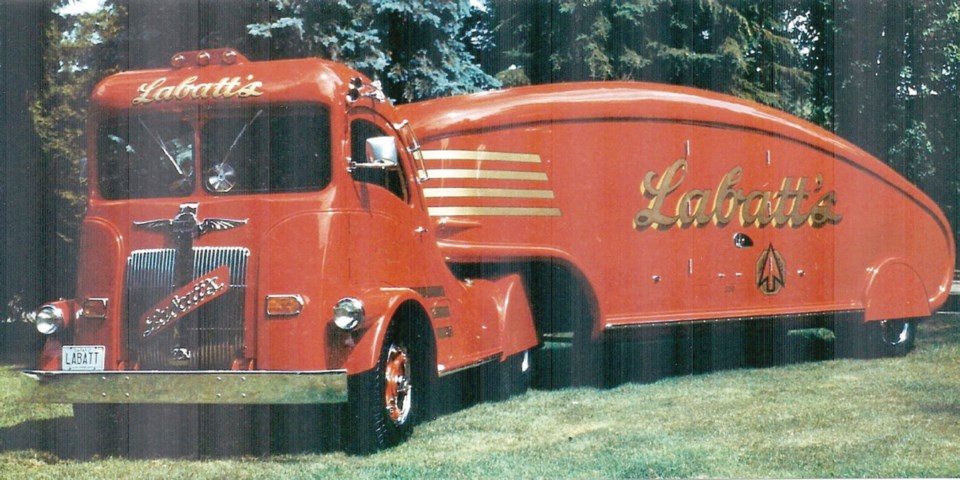Although Prohibition ended in Ontario in 1927, beer advertising continued to be banned in the media, so brewers sought legal and novel ways to publicize their products. One of the most imaginative came from the Labatt Brewing Company of London, Ont.: the Labatt “Streamliner” tractor-trailers.
In the 1930s, Labatt changed from rail shipping to road haulage of beer. Needing a new fleet of large trucks, they decided to combine highway delivery with mobile advertising. Wanting more than the drab, rectangular transports then in use, they conceived the idea of the Labatt Streamliner as a stylish rolling billboard.
Labatt turned to Count Alexis de Sakhnoffsky, a Russian-born count who had escaped to France following the revolution. After studying art and engineering, he became art director for Belgian custom coach builder Van den Plas. De Sakhnoffsky emigrated to the United States in 1928, where he styled everything from American Austins to supercharged Auburns.
Labatt engaged de Sakhnoffsky in 1935 to design the Streamliner. He ultimately created four generations of them, and although all were ahead of their time, the 1947 iteration was the most dramatic.
The 1947 model’s cab-over-engine tractor had a beautifully curvaceous shape, with the rear end sweeping down in a steep unbroken line to fully skirted dual wheels. The equally striking trailer complemented the cab’s fastback shape, with the body arcing gently front to rear. De Sakhnoffsky’s trademark dorsal fin decorated the roof and enclosed dual wheels finished off the integrated appearance.
The Streamliner program began in 1937 with Smith Brothers of Toronto making the bodies out of hardwood and aluminum. Fruehauf produced the single-axle, low-bed trailers and White Motor Co. supplied the tractor chassis. The futuristic Streamliner won “Best Design” award at the 1939 New York World’s Fair.
The Streamliner was more than just style — it was the first Canadian tractor-trailer with a fifth-wheel anti-jackknifing device, and the first with air brakes. Power came from a White “Mustang” 6.3-litre, 135-horsepower six-cylinder engine driving through a five-speed transmission.
The Streamliners met Labatt’s requirements for more payload and higher speed. While typical tractor-trailers carried five tonnes and attained only 56 km/h, the Streamliners hauled 8.5 tonnes and reached 80 km/h.
The Streamliner’s appearance was enhanced by dramatic red paint decorated with genuine gold leaf script. Labatt complemented them with its Highway Courtesy Program, staffed by smartly uniformed drivers trained to assist in everything from flat tires to accidents. It generated very positive publicity for Labatt on Ontario roads.
The last-generation Streamliners were ordered by Labatt in 1941, but the Second World War delayed rollout until 1947. In addition to the 10 Streamliners, there was a special order from Princess Julianna of the Netherlands, who was staying in Canada during the war. She admired the Streamliner so much she wanted one to transport her ponies.
This was the last fleet of Streamliners. Although they made a bold styling statement, their time was passing. The bodies were expensive and time-consuming to build, and cargo capacity was small by contemporary standards. The shape was not very efficient and the side-opening doors precluded pallet loading. Plus, other methods of advertising were now available.
The Streamliners were retired in the mid-1950s and gradually faded from memory. Then in 1977, Joe Scott of London, Ont., along with Labatt, decided this piece of Canadiana should be preserved. Joe had recently retired as president of White Truck Sales in London, which serviced the Streamliners, and with Labatt’s financial support he and longtime Labatt employee and brother Bob set out to find a 1947 Streamliner to restore.
They eventually unearthed six trailers in Ontario. One, a construction field office, was tatty but restorable.
The tractor was another matter. They wrote to every White branch in North America without success. A $500 finder’s reward generated wide publicity, but no tractor. Joe however, unexpectedly purchased a batch of fenders in the Netherlands. Perhaps Julianna had bought them as spares.
The determined Scotts finally found two 1947 White cab-over trucks and began to recreate the Streamliner tractor. Working from photographs and using a computer, blueprints were developed to accuracy within 0.8 millimetres of the original dimensions and shape.
Using panel-beating hammers and a metal-shaping wheeling machine, the aluminum cab was painstakingly recreated. The project was finally completed, and the authentically restored 1947 Streamliner was on the road in 1983.
The Streamliner was honoured by appearing on a Canadian postage stamp in 1996. Owned by Labatt, the Streamliner is a roving goodwill ambassador that appears at fairs, exhibitions and other public events. To everyone’s delight, its horn doesn’t just toot, it plays How Dry I Am.
